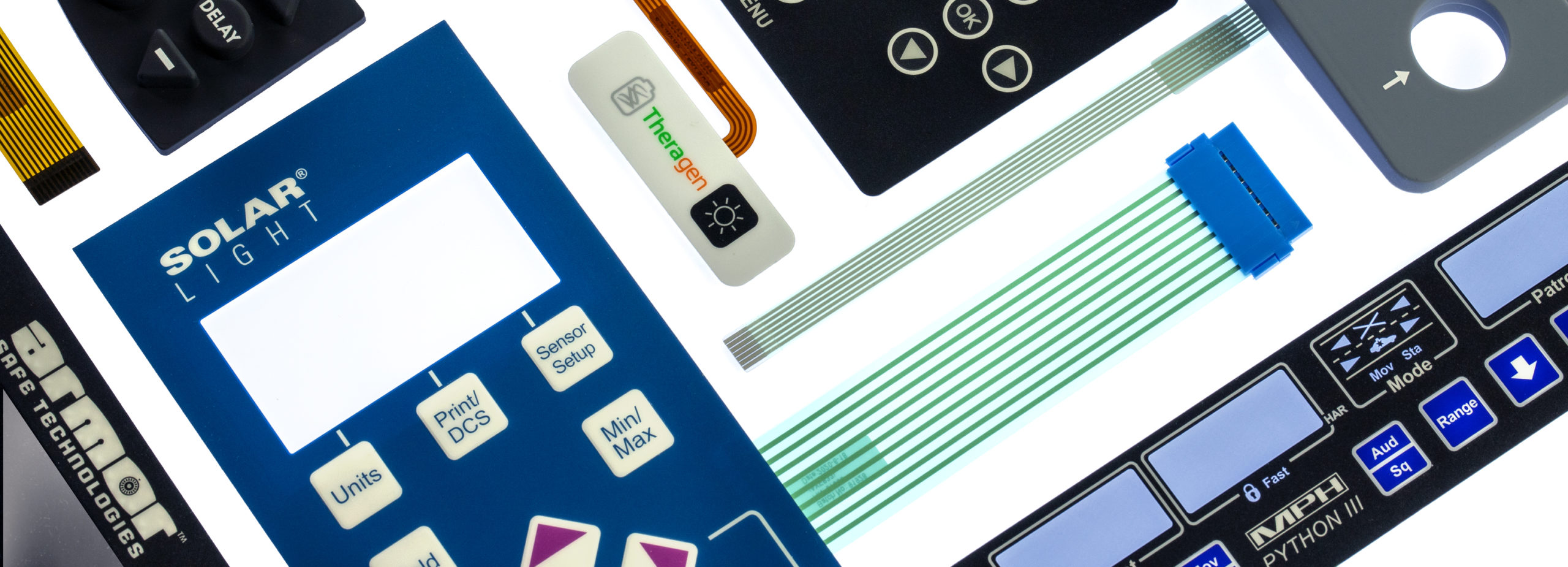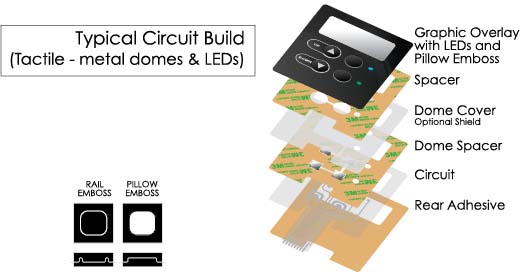How Membrane Switches Are Shaping the Future of Electronic Interfaces
How Membrane Switches Are Shaping the Future of Electronic Interfaces
Blog Article
Recognizing Membrane Layer Switches Over: The Key to Trustworthy and sturdy Controls

What Are Membrane Layer Buttons?
Membrane switches are an innovative remedy in the realm of interface innovation, integrating performance and design perfectly. These gadgets offer as an interface between individuals and digital systems, incorporating numerous parts right into a portable layout. Generally constructed from versatile, thin layers of materials, membrane layer buttons are designed to react to touch, enabling users to engage with equipment and digital gadgets successfully.
The key aspects of a membrane layer button include a published circuit layer, visuals overlay, and a spacer layer that avoids unexpected activation. The graphic overlay can be customized to show brand identification or customer choices, boosting looks while making sure functionality. Membrane buttons are typically made use of in different applications, consisting of clinical devices, customer electronic devices, and industrial devices, owing to their durability and resistance to environmental aspects such as wetness and dirt.
Among the essential advantages of membrane switches is their capacity to hold up against wear and tear, making them ideal for high-traffic environments. Furthermore, they are lightweight and require minimal space, enabling for cutting-edge layouts in item growth. In general, membrane changes represent a reliable and sensible option for modern electronic user interfaces, weding innovation with user-centric design principles.
How Membrane Changes Work
The operation of membrane layer switches over hinges on a simple yet effective device that converts user input into digital signals. These switches contain numerous layers, generally including a visuals overlay, a spacer layer, and a circuit layer. When an individual presses the button, the top layer warps, enabling a conductive aspect in the circuit layer to make call with a matching conductive pad on the bottom of the visuals overlay. This get in touch with shuts the circuit and sends out a digital signal to the tool, showing that the switch has actually been activated.
The layout of membrane layer switches can vary, however they typically integrate domes or tactile aspects to supply responses to the individual, improving the general experience - membrane switch. The materials made use of in membrane layer switches, such as polyester or polycarbonate, add to their toughness and resistance to environmental variables, consisting of wetness and dirt. In addition, the printed circuits are generally enveloped, which safeguards them from damage in time.
Benefits of Membrane Layer Buttons

Furthermore, membrane layer switches are recognized for their durability. Built from robust products, they are immune to dust, wetness, and physical wear, which considerably expands their life expectancy compared to standard mechanical switches. This sturdiness makes them specifically suitable for high-traffic settings and applications requiring durability.
Another significant benefit is the ease of cleansing and maintenance. The smooth surface area of membrane layer switches reduces dirt buildup and is frequently unsusceptible spills, making them excellent for settings that need regular sanitization.
Furthermore, membrane layer buttons provide a streamlined profile, leading to a thinner design that can be integrated into different devices without adding mass. This feature not only enhances the visual allure yet also adds to a more ergonomic item style.
Applications of Membrane Layer Buttons
Flexible and user-friendly, membrane layer switches locate applications across a vast variety of sectors, consisting of clinical tools, consumer electronic devices, and commercial devices. In the medical area, these buttons are essential to tools such as diagnostic devices, person surveillance systems, and mixture pumps, where reliability and convenience of cleaning are vital. Their ability to maintain and withstand extreme atmospheres functionality makes them why not look here suitable for such applications.

In consumer electronics, membrane layer switches are made use of in products like microwaves, cleaning makers, and remote controls - membrane switch. Their smooth design enables for instinctive individual interfaces, boosting the total individual experience while providing durability and resistance to put on and tear
Commercial devices also gains from membrane buttons, particularly in control panels for equipment and automation systems. These switches offer protection versus dirt and wetness, guaranteeing regular performance in challenging environments. Furthermore, their personalized functions enable manufacturers to tailor them to details operational demands, boosting performance and functionality.
Choosing the Right Membrane Switch
When choosing a membrane layer button, it is important to take into consideration numerous aspects that affect performance and suitability for specific applications. The key factors to consider include ecological conditions, tactile click comments, toughness, and design specifications.
First, assess the operating setting; buttons exposed to wetness, chemicals, or severe temperatures require details products to guarantee longevity and performance. Next off, examine the need for responsive comments. Relying on user communication, some applications may take advantage of a responsive feedback to validate activation, while others might favor a non-tactile layout for aesthetic factors.
Durability is an additional crucial factor; membrane switches ought to be developed to withstand constant usage, impacts, and abrasion. Guarantee the chosen switch can sustain the expected lifecycle, especially in high-usage scenarios.

Verdict
Finally, membrane switches function as necessary parts in the layout of trusted and resilient control systems throughout numerous industries. Their compact layout, combined with robust building and construction and customizable attributes, improves individual interaction while guaranteeing long life popular environments. The versatility of membrane layer switches over permits tailored solutions that satisfy specific functional requirements, reinforcing their importance in modern-day technology. As industries remain to evolve, the relevance of incorporating reliable membrane layer switch solutions can not be overstated.
Membrane switches over stand for a critical facet of contemporary interface style, mixing functionality with durability in numerous applications.Membrane layer buttons are an advanced service in the realm of user interface technology, integrating performance and style flawlessly. Normally created from adaptable, thin layers of materials, membrane buttons are developed to respond to touch, allowing users to connect with equipment and electronic gadgets properly.
The layout of membrane buttons can vary, however they typically integrate domes or tactile components to provide feedback to the user, boosting the general experience.In verdict, membrane switches over serve as essential elements in the style of durable and trusted control systems throughout different sectors.
Report this page